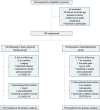Home physical therapy versus telerehabilitation in improving motor function and quality of life in Parkinson's disease: a randomized controlled trial
- PMID: 39578754
- PMCID: PMC11583509
- DOI: 10.1186/s12877-024-05529-6
Home physical therapy versus telerehabilitation in improving motor function and quality of life in Parkinson's disease: a randomized controlled trial
Abstract
Background: Over the past few years, the development of telerehabilitation has advanced rapidly. Patients with Parkinson's disease (PwPD) often have difficulty with mobility, making it challenging for them to perform centre-based exercise.This study aims to compare the effectiveness and adherence of home physical therapy (HPT) and telerehabilitation (TR) in mitigating motor symptoms and improving the quality of life in patients with mild to moderate Parkinson's disease.
Methods: This randomized controlled trial included a total of 190 patients who underwent in-person eligibility assessment, with 100 allocated to the HPT group and 90 to the TR group. Both interventions consisted of home-based training sessions lasting 40-60 min and were conducted five times a week for 4 weeks. The primary outcome was the Unified Parkinson's Disease Rating Scale motor section (UPDRS3) score. Secondary outcomes included balance function, assessed using the Berg Balance Scale (BBS); risk of fall, evaluated through the Timed Up-and-Go test (TUG) and the Five Times Sit-to-Stand test (FTSST); gait, measured using the Freezing of Gait Questionnaire (FOGQ) and IDEEA activity monitor; muscle strength, evaluated using the isokinetic dynamometry; motor aspects of experiences of daily living (UPDRS2); and quality of life, assessed by Parkinson's Disease Questionnaire-39 (PDQ-39).
Results: There was a significant difference in the UPDRS3, BBS, TUG, FTSST, FOGQ,step length, step velocity,preswing angle, UPDRS2 and PDQ-39 between baseline and 4 weeks in both groups. The decrease in the UPDRS3 score was significantly greater in the HPT group (-3.38 points) than in the RE group (-1.45 points) in the older age group (P = 0.021), but there was no significant between-group difference in the younger age group (P = 0.416). Similar changes favouring the HPT group were observed in the BBS, TUG, step velocity, and extension average torque. 7 (7%) patients in the HPT group and 12 (13%) patients in the TR group did not complete their daily exercise plan.
Conclusions: Both HPT and TR have demonstrated effectiveness, safety, and feasibility in PwPD. However, the HPT program exhibited greater effectiveness among older patients and higher patient compliance compared to TR.
Trial registration: Chictr.org.cn, ChiCTR2300071648. Registered on 22 May 2023-retrospectively registered, https://www.chictr.org.cn/showproj.html?proj=196313 .
Keywords: Home physical therapy; Motor function; Parkinson’s disease; Quality of life; Telerehabilitation.
© 2024. The Author(s).
Conflict of interest statement
Declarations. Ethics approval and consent to participate: Approval for the trial protocol was obtained from the Medical Ethical Committee of Peking Union Medical College Hospital. All patients provided written informed consent at the beginning of the assessment. Consent for publication: Not applicable. Competing interests: The authors declare no competing interests.
Figures


Similar articles
-
The effect of task-oriented circuit training-based telerehabilitation on upper extremity motor functions in patients with Parkinson's disease: A randomized controlled trial.Parkinsonism Relat Disord. 2023 Apr;109:105334. doi: 10.1016/j.parkreldis.2023.105334. Epub 2023 Feb 28. Parkinsonism Relat Disord. 2023. PMID: 36917914 Clinical Trial.
-
LSVT® BIG versus progressive structured mobility training through synchronous telerehabilitation in Parkinson's disease: A randomized controlled trial.Neurol Sci. 2024 Jul;45(7):3163-3172. doi: 10.1007/s10072-024-07322-0. Epub 2024 Jan 25. Neurol Sci. 2024. PMID: 38267603 Free PMC article. Clinical Trial.
-
Erratum.Mult Scler. 2016 Oct;22(12):NP9-NP11. doi: 10.1177/1352458515585718. Epub 2015 Jun 3. Mult Scler. 2016. PMID: 26041800
-
Effectiveness of Telerehabilitation on Motor Impairments, Non-motor Symptoms and Compliance in Patients With Parkinson's Disease: A Systematic Review.Front Neurol. 2021 Aug 26;12:627999. doi: 10.3389/fneur.2021.627999. eCollection 2021. Front Neurol. 2021. PMID: 34512495 Free PMC article.
-
Effects of virtual reality rehabilitation training on gait and balance in patients with Parkinson's disease: A systematic review.PLoS One. 2019 Nov 7;14(11):e0224819. doi: 10.1371/journal.pone.0224819. eCollection 2019. PLoS One. 2019. PMID: 31697777 Free PMC article.
Cited by
-
Effects of remote Baduanjin Qigong intervention on quality of life and physical function in patients with mild to moderate Parkinson's disease: a protocol of randomized controlled trial.Front Neurol. 2025 Aug 6;16:1620424. doi: 10.3389/fneur.2025.1620424. eCollection 2025. Front Neurol. 2025. PMID: 40843258 Free PMC article.
References
-
- Bloem BR, Okun MS, Klein C. Parkinson’s disease. Lancet. 2021;397(10291):2284–303. - PubMed
Publication types
MeSH terms
LinkOut - more resources
Full Text Sources
Medical
Miscellaneous

